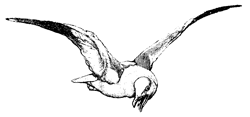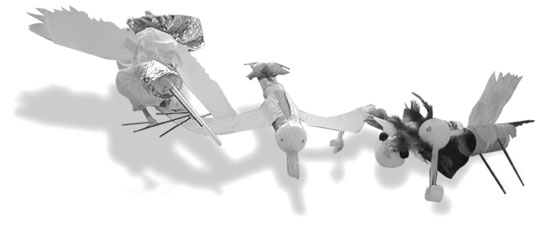|

 n
the four days of the Winter Meeting, SCIMAST staff presented several
activities to frame the participants' field experiences. The following
summaries show how a few of these activities could be reworked for
students of all ages. They could be used to introduce students to
the field work or to help them sum up their observations. n
the four days of the Winter Meeting, SCIMAST staff presented several
activities to frame the participants' field experiences. The following
summaries show how a few of these activities could be reworked for
students of all ages. They could be used to introduce students to
the field work or to help them sum up their observations.
Since the participants in the Winter Meeting have been coming
together twice a year for at least three years, they know each other
well. Even so, they had not constructed a common understanding of
the material to be studied. The first task SCIMAST staff faced was
to offer ways to help the participants build shared assumptions
about systems.
Describing a System
In the Winter Meeting. In small groups of three or four,
the participants were given envelopes with the names of the general
parts of a system (input, output, feedback mechanisms, components,
subsystems) and the name of a specific system (circulation, transportation,
legislative, school, hospital, McDonalds). The task for each small
group then was to show how the specific system they received illustrated
the general parts common to all systems.
The participants described the system they received on chart paper
and then discussed it among the groups. At the end of the discussion
each participant wrote an operational definition of a system. This
definition was to be refined throughout the four days. In discussions
the definitions were referred to and reworked until the last day.
In the Classroom. Even young students can recognize some parts
of a system, although they may not have the vocabulary to name or
describe those parts. Concepts introduced in class may need to be
discussed again so students can rethink their understanding of systems.
This activity may help students who have already been introduced to
the concepts to think more deeply about them in relation to systems
and the natural world.
Most students will need names of familiar systems. While it may
stretch the thinking of adults and older students to discuss legislative
and respiratory systems together, younger students may be confused
if the teacher has not explained earlier how the systems resemble
each other. In some cases the teacher may need to be very explicit
in eliciting the similarities among the systems and helping children
think about their commonalties.
Building a Bird
 Marine
Science Institute staff introduced the PDAs to the characteristics
of the barrier island ecosystem and its resident species through
maps, slides, and general descriptions. The participants then began
to work on constructing models of birds that were adapted to the
conditions found in various parts of the Port Aransas system. Long-legged
birds that walk along the shoreline eating small creatures could
be constructed from straws and Styrofoam bodies. Beaks could be
fashioned from macaroni shells. Other items available in the array
of materials--feathers, construction paper, beads, sequins, and
any other items that appealed to their interests--could be used
to form the entire bird. Marine
Science Institute staff introduced the PDAs to the characteristics
of the barrier island ecosystem and its resident species through
maps, slides, and general descriptions. The participants then began
to work on constructing models of birds that were adapted to the
conditions found in various parts of the Port Aransas system. Long-legged
birds that walk along the shoreline eating small creatures could
be constructed from straws and Styrofoam bodies. Beaks could be
fashioned from macaroni shells. Other items available in the array
of materials--feathers, construction paper, beads, sequins, and
any other items that appealed to their interests--could be used
to form the entire bird.
The exercise gave participants an opportunity to demonstrate their
understanding of how creatures' physical adaptations conform to
environmental needs. Discussions, not only with the whole group
but also during the creation of the models, showed shared depth
of understanding. Participants worked out how structure and function
were related in birds' anatomy and indicated that they knew, for
example, that wading birds would need long legs and that the shape
of its bill governs what a bird eats. Using these understandings
they built workable models of, often fanciful, birds.
In the classroom. Students may be tempted to focus on the
inventiveness of their creations, but conversations will reveal
the quality of their thinking about habitat and adaptation. Moving
from group to group while students are constructing their birds
will help the teacher understand their thinking. Students can also
explain their constructions to the whole group in presentations
that become, in essence, performance assessments.

The Town Meeting Simulation
Based on an activity developed by Project Wild (see "To Zone or
not to Zone" in the second edition of Project Wild: K-12 Activity
Guide; available from Project Wild at 707 Conservation Lane, Suite
305, Gaithersburg, MD 20878), the Town Meeting simulation gave participants
an opportunity to reflect on their observations and apply them in
a realistic context. Participants would see that changing part of
a system affects not only that system but also other systems and
their interconnections. The exercise also made clear that all systems,
both those created by humans and by nature, are interconnected.
The simulation can be reworked for almost any age group. The role-playing
aspects make it equally interesting for adults and younger children.
A simulation such as this one could be the culmination of many
different field trips. Students could debate planned changes in
roads around a site, proposals to make an area into a park or to
remove it from the park system, the creation of a nature preserve,
delisting an animal or plant as an endangered species, or similar
subjects connected with their field experience. Ways to adjust this
simulation for school use will be discussed alongside descriptions
of how it played out in the Winter Meeting rather than separately.
Introducing the Issues
Periodically, people in this part of Texas suggest that a channel
should be reopened to connect Corpus Christi Bay to the Gulf of
Mexico. Tourism businesses, fishing enthusiasts, and real estate
interests support creating a channel. Many ecologists oppose the
channel, as do those who worry about safety during a big hurricane,
fiscal conservatives and taxpayer groups, and tourism business-people
in smaller towns who fear that a channel would draw visitors to
Corpus Christi and away from them.
While this activity may appear to be best suited to older students,
it can be altered for children of all ages. As part of their introduction
to the field experience, older students could identify and research
the political, economic, and social issues of the site. The time
devoted to research and presentation, the level of sophistication
of the arguments, and the depth of detail presented will all be
functions of the students' ages. Age-appropriate introductions will
help young students deal with complex issues within this context.
Children could use a simulation as an introduction to the topic
rather than a summing up. A short simulation with different parts
for each child might usefully introduce youngsters to broader concepts
involved in their field trip.
Preparing to Debate
For the Town Meeting simulation, SCIMAST staff prepared extensive
descriptions of the issues connected with the proposed Packery Channel
and developed a stable of personalities to argue for each side.
Supporters and opponents of the channel were more or less even in
number. Participants were to argue before a mock city council made
up of other participants.
Each participant was randomly assigned a character in the controversy
as part of the information packet. If students develop their own
materials, they may want to develop their own characters. Alternatively,
the teacher may expect them, like debate team members, to be able
to support any point of view.
Some participants were cast as members of the city council, one
as the mayor who presided over the meeting. In a classroom, these
roles could be randomly assigned like the others or could be voted
on from the class. After the role players have presented all sides
of the controversy, the city council members and mayor vote on the
project.
In the SCIMAST simulation participants were given 15 minutes to
read their information on the channel controversy and 15 minutes
to caucus in "for" and "against" groups. Students, of course, could
take much longer working to find their own information and forming
advocacy groups within the class. Preparing information on all sides
of issues could be part of their pre-visit work or could be an assignment
when they return to class from the field.
Even with very little time to prepare, the participants presented
various positions fairly by drawing on what they had learned in
the previous days. In a school, cooperation with the civics teacher
or debate coach at this stage could make the field experience interdisciplinary.
Simulation as an Assessment
The simulation is an opportunity for student reflection. As individuals
and in their groups they need to rethink what they have learned
and what meaning it has for them. If it is presented after the field
trip, the simulation can also be an assess-ment. As an assessment,
it allows each student to display his or her learning from the field
and understanding of the broader social and political issues connected
with the environment. Students should be aware of what will be expected
of them both before and during the field experience so they can
be gathering their thoughts in an organized manner with the simulation
as a goal.
The complexity of this activity can deepen for older students.
Students may chose to present position papers and oral arguments
as part of the simulation and as part of the assessment of their
learning. Each student could prepare a portfolio of his or her own
position paper and the research that lead up to it, observations
made at the site, prepatory work that lead up to the field trip,
or other evidence of learning. The final vote could also be included
in all portfolios along with individual discussions of those results.
Closure
After the simulation was over, SCIMAST presented the participants
with several prompts for discussion and reflection:
- How much of the debate on the Packery Channel actually focused
on environmental issues?
- What role did economics and politics play in the debate?
- How can people learn to balance conflicting principles?
- How can we educate students to make good decisions in these
types of situations?
- What happens when you have conflicting scientific data? How
do you decide whom to believe? How do you establish priorities?
In a classroom setting these questions could become the basis
of essays or classroom debates. One or more could form the core
of an assessment protocol, perhaps as questions the teacher could
use to organize feedback to the students.
Copies of the original town meeting activity are available. These
copies are more extensive than the presentation here and include
supporting materials developed by the SCIMAST staff. If you would
like a copy, please contact a SCIMAST staff member or write to
Classroom Compass
Southwest Educational Development Laboratory,
211 E. Seventh St.
Austin, TX 78701-3253
|


